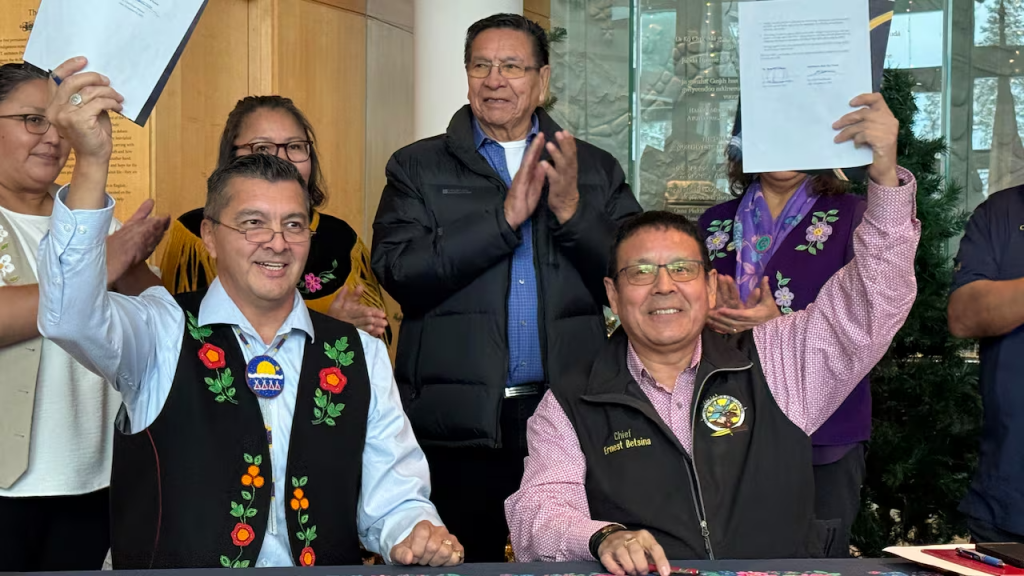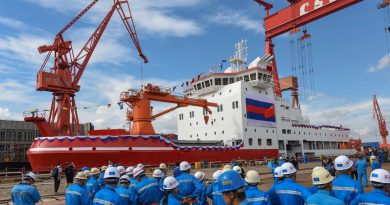Yellowknives Dene and Tłı̨chǫ government sign MOU to take lead on Arctic security corridor

Tłı̨chǫ Grand Chief described the project as ‘a long-lasting legacy’
The Tłı̨chǫ government and the Yellowknives Dene First Nations (YKDFN) have committed to jointly lead the Arctic economic and security corridor project.
Tłı̨chǫ Grand Chief Jackson Lafferty and YKDFN Chief Ernest Betsina signed a memorandum of understanding (MOU) on Monday in front of a group of chiefs, territorial and federal representatives and other members of the public at the N.W.T. Legislative Assembly in Yellowknife.
In a speech before the document was signed, Lafferty highlighted the significance of the two nations coming together. He said they will work collaboratively with the territorial and federal government, but that ultimately the two nations would be taking the lead.
“We’ve learned from past experiences with industries coming into our backyard and them making all the decisions. We are going to flip that around now, we are going to lead the mega-project, said Lafferty. “[The project] will be on our terms moving forward.”
Proposed all-season road
The Arctic economic and security corridor involves a proposed all-season road which would connect the N.W.T. to a port at Grays Bay in Nunavut.
The security corridor has not made it on Prime Minister Mark Carney’s initial list of nation-building projects he wants to fast-track.
The proposed all-season road would pass through Tłı̨chǫ and YKDFN land.
Betsina said the project would support jobs and skill training, create long-term contracts for community members, and has the potential to change transportation.
The signing of the MOU is one of many steps.
Land access, environment, economy to be discussed
Both Lafferty and Betsina indicated that many parts of the project are still in the preliminary stages and discussions with the federal and territorial government are ongoing.
They also spoke of safeguarding the land and wildlife, including caribou, throughout the project.
The main priority for the YKDFN, Betsina said, will be to engage community members.
“Our members will be asked for their views on land views, access, environmental considerations and economic opportunities,“ he said, indicating that traditional knowledge from elders must also guide their approach.
Other steps include forming working groups in both First Nations, carrying out environmental and technical studies and creating a proposal to submit to the federal government.
“This is a long-lasting legacy that we’re going to start working on. It’s a mega project that’s going to last 50, 100 years down the road,” Lafferty said. “It has to involve the communities.”
Related stories from around the North:
Canada: New Nunavut premier takes office as federal government pushes infrastructure drive, CBC News
Finland : Sami turn down participation in Lapland wind power survey, Eye on the Arctic
Norway: Norway, UK team up to protect subsea infrastructure against Russian hybrid attacks, The Independent Barents Observer
Russia: Putin in Arkhangelsk: Arctic industry and infrastructure on agenda, The Independent Barents Observer
Sweden: Electricity to get more expensive in the north due to new Sweden-Finland powerline, Radio Sweden
Russia : Russian nickel miner wants nuclear power for Arctic plant, The Independent Barents Observer
United States: Alaska Ambler Road project back in focus as company outlines vision for work ahead, Eye on the Arctic



